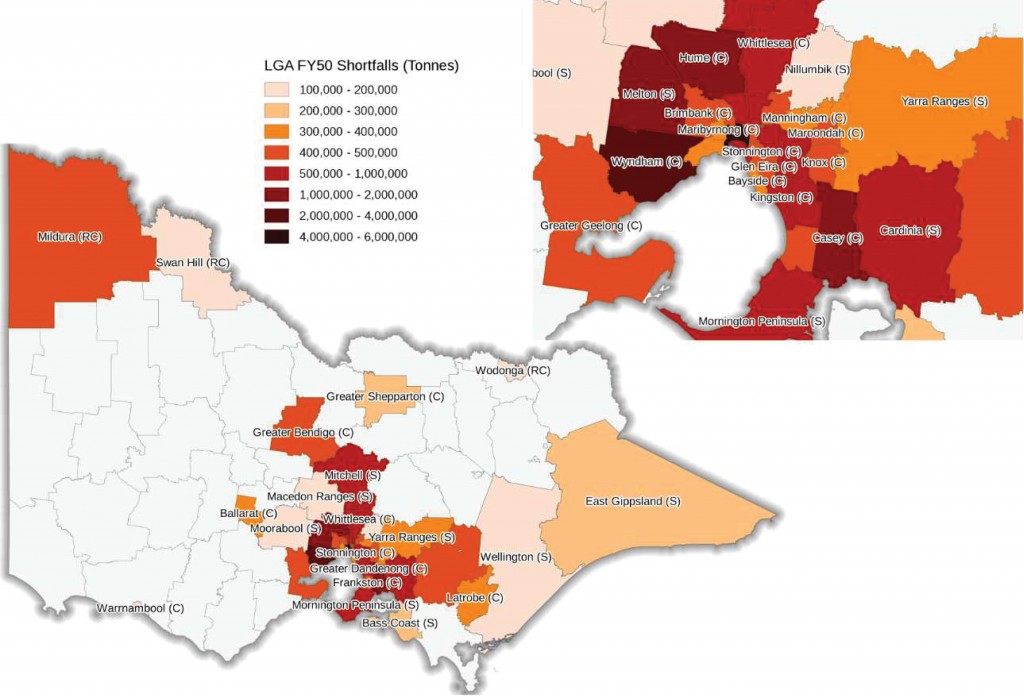Demand and Supply Study

DR ELIZABETH GIBSON, General Manager of the CMPA reports on the Extractive Industries Taskforce, Demand and Supply Study.
DEDJTR and the Extractive Industries Taskforce chaired by DEDJTR with representatives from Minerals Development Victoria (DEDJTR), Transport (DEDJTR), Planning (DELWP) and industry
associations including CMPA (Dr E. Gibson) was an initiative of the Extractive Resources in Victoria: Demand and Supply Study 2015-2050 (Study) in 2014. The aim of the Study was to investigate a range of challenges facing the extractive industry:
- Potential sterilisation of prospective extractive resources by urban and regional development;
- Encroachment of urban and regional development into existing quarrying areas; and
- The nearly doubling of demand for extractive resources over the 2015-2050 period will lead to an increase in the need for transport infrastructure.
The following are the aims of the Study:
- Identifying and quantifying current and forecast demand and supply profiles for Victorian extractive resources over two time periods: 2015-2025 and 2026-2050, including scenario analysis.
- Assessing the economic value of the State’s extractive resources, in terms of implications for cost and/or availability of infrastructure and other construction activity if certain extractive resources are not available close to where they are needed for construction activity.
- Determining which extractive resources (including location) are likely to be of strategic value to the State. A strategic resource criteria framework and associated measures have been developed in consultation with the Department and Extractive Industries Taskforce.
- Conducting spatial analysis through the production of detailed maps of extractive resource locations, including linkages to areas of current and future demand, transport corridors and market linkages, potential synergies and impediments.
Primary supply data was collected through comprehensive industry consultation (in which Members may have participated), which comprised 81 per cent of Victorian industry as measured by the level of 2014 extractives production in Victoria. This data, which represents industry’s views and plans as indicated at a point in time, was used to develop supply projections over two time periods: 2015 to 2025 and 2026 to 2050. Notably, industry respondents stated they were less confident in the response provided for the latter time period, 2026 to 2050, relative to the first time period.
Some of the key findings were:
- 50% of Victoria’s construction activity to 2026 is comprised of residential development.
- 89% more quarry resources will be required for construction state-wide by 2050 (88 million tonnes, up from 46 million tonnes in 2015).
- 34% of Victoria’s requirements for quarry resources by 2050 will need to be sourced from new quarries which have not yet been planned.
- 11 billion tonnes of quarry resources are forecast to be available from current and planned quarries across Victoria by 2050.
There are a few concerns about the magnitude of the above forecasted figure of 11 billion tonnes and that the predicted shortfalls in materials such as hornfels may be inaccurate. The 11 billion tonnes figure is dependent on a 56% increase in new Work Authorities. This equates to 18 approved (and viable) Work Authorities per annum to 2050 based on the WorkSafe number for quarries being 1100. Clearly, there is an issue. As CMPA Members will know, the likelihood of approval for a viable quarry is becoming less and less due to the ever increasing legislative requirements from ERR, Aboriginal Heritage, Native Vegetation, Catchment Management Authorities and the political environment within which Planning Authorities make decisions etc.. The exorbitant costs especially to appeal a decision at VCAT) and uncertainty of the decision making process makes investment in the extractive industry in Victoria unattractive. For example, a recent VCAT hearing decision, Auswide Developments Pty Ltd V Greater Shepparton 25 August 2016, for a proposal to extract up to approximately a total of 20,000 m of sand less than 2m deep added an extra 49 conditions (408 m 3 sand per condition)! The case referred to in the VCAT decision from 8 years earlier as being similar was for a sand quarry 10 times greater in volume with only an extra 32 conditions (6250 m 3 sand per condition).
The Report is timely. It will assist in highlighting to Government and the community the importance of extractive resources in light of Victoria’s continuing population growth expectations of 100,000 per annum. At approximately 7 tonnes per person per annum of extractive resources used in Victoria this equates to an increase of 700,000 tonnes per annum vital to the Victorian
economic development, jobs and liveability.
The Extractive Resources Study to 2050 Report is available at http://earthresources.vic.gov.au.
Please see the article on page 13 ‘Meeting with the Minister’ for further recommendations for the Study.











You must be logged in to post a comment Login